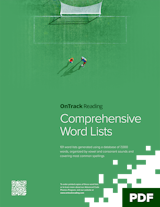Want more word lists constructed from a children's dictionary?
See Comprehensive Word Lists
Interested in the phonics program that uses these word lists?
See the OnTrack Reading Advanced Code Phonics Workbook
The two lists of four-syllable words at the top are used in the OnTrack Reading Multisyllable Method. The first list contains 25 words on two pages separated into chunks according to the method's Main Rule and Three Exceptions. The second contains 90 words on two pages presented as normally appearing words. Some of these are more than four syllables, incidentally.
Using the Chunk-by-Chunk List
Again, all of the 4-syllable words are chunked according to the application of the Main Rule and the Three Exceptions. As was the case before, direct your child to try the First Vowel Sounds on the first attempt at reading the word unless he already knows the word and reads it accurately.
Depending upon the age and sophistication of your child, some of the words in the 4-syllable lists will be difficult to decode because they will not be in his listening vocabulary. You will already have noticed this in the case of some of the 2-syllable and 3-syllable words. The problem is that your child will not know when he’s reached the word by systematically trying various vowel sound options.
You can address this situation by previewing a book that you’re reading with your child and picking five to ten longer words out that you think he might struggle over. Figure out how they should be chunked according to the Main Rule and Three Exceptions and just write them out in longhand, mimicking the worksheet format. Then have your child practice on those words instead of the ones on the worksheet. This will also give you some practice with the chunking method before you teach it to your child.
Decoding “a-tion”
When you get to the chunked word o-per-a-tion, your child should pronounce every chunk as it actually sounds except the third, where he should say the /a/ sound (as in cat) if he’s properly trained. If he immediately corrects his pronunciation, go over the word and make sure he recognizes that he changed the /a/ sound to the /ae/ sound. If, on the other hand, he pronounces it with the /a/ sound and doesn’t recognize it, just point to the letter a and tell him to try the Second Vowel Sound, /ae/, at which point he should be successful in recognizing the word.
Once he gets the word correct, and understands that he changed to the Second Vowel Sound, tell your child that he should learn a shortcut when he sees the letter a in front of tion. Tell him that thousands of words have that pattern at the end and that in almost every one the letter a is the Second Vowel Sound, so he should just say /ae/ when he sees it in front of tion.
When he gets to in-vi-ta-tion a little later, remind your child of the shortcut without telling him specifically what it was and see how he does. If he remembers it, he will decode invitation on the first attempt. Then keep reinforcing the shortcut until he gets comfortable with the recurring pattern.
Conclusion
This completes the description of the multisyllable lessons found in the OnTrack Reading Advanced Code Phonics Workbook. If I were teaching middle-school students and had a group who were uncomfortable decoding grade level multisyllable words, I would be tempted to spend five or ten minutes per class period, for the first few weeks, explaining this simple approach to decoding multisyllable words.
Then, during the rest of the year, I would chunk vocabulary words on the board as they came up either in reading or discussion, and would keep discussing the various vowel sound options (and some of the consonant options as well) throughout the year. At the end of the year, I am confident that this would pay huge dividends for certain students. Another section of my website, Phonics for Older Students, explains in more detail how this could be done.
Always bear in mind, however, that some students don’t read well because their poorly functioning visual systems keep them from concentrating on close-up work, particularly print. If a student clearly understands the multisyllable decoding process, but avoids reading for no apparent reason, you must consider the possibility that a vision problem is present, especially if that student has an older sibling or a parent who also struggled to learn to read.
On the next page, Spelling Words from Auditory Memory, I explain how auditory memory can be effectively used to help with the spelling of many words, rather than having to rely solely upon visual memory.


